|
Related FAQs: TWA
Invertebrates, Fishes of the Tropical
West Atlantic, Tropical West Atlantic
2,
Related Articles: Algae,
Vascular Plants, Introduction
to Fishwatcher's Guide Series Pieces/Sections, Lachnolaimus maxiumus/Hogfish, Hogfishes of the Genus
Bodianus,
Invertebrates, Algae and Vascular
Plants of The Tropical West Atlantic: Bahamas to Brazil, Part
5
To: Part 1, Part 2, Part 3,
Part 4, Part
6, Part 7, Part 8, Part 9,
|
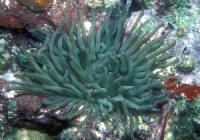 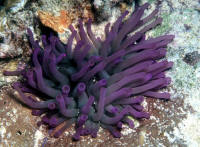
|
| Bob Fenner |
Condylactis gigantea
|
Anemones of the
Tropical West Atlantic, Condylactis
Anemones,
Zoanthids in
Cnidarian Classification:
Bothersome hydras, jellyfish, sea
anemones, tube anemones, reef and non-reef-building corals, soft and
hard, black, horny and stony, sea pens, sea pansies , sea wasps,
Portuguese men of war and sea fans; these are the stinging-celled
animals, the Cnidaria ("Nigh-dare-ee-yah"); in some older
texts as the Phylum Coelenterata
These organisms are radially
symmetrical (hence inclusion in a sub-Animal Kingdom, the Radiata), are
made up of two basic tissue layers and possess salient
"stinging" cells. These are grouped as thread-like (volvent)
barbed/spined with and without toxins (penetrant), and
"sticky" for anchoring (glutinant).
Their body shapes come in two basic
formats; a sessile polyp-like and free-swimming medusa-like. The basic
features of these body-types are evident; most species are either one
or the other, medusoid or polypoid, others pass through both in their
life cycle. The body cavity formed by the tissue layers bears series of
tentacles around a single body/mouth/"anus" opening/mouth
(the coelenteron).
| Parazoanthus catenularis, Brown Sponge
Zoanthid. Polyps of about 1/8" diameter bear 20 brown to
yellow pointed tentacles, with oral disks that are darkened in
their centers. Cozumel pic by Di. |
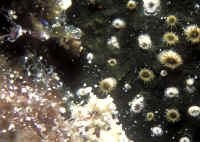
|
| Parazoanthus parasiticus, the Sponge
Zoanthid. Small (1/8" diameter) greenish tentacled polyps
embedded in a sponge... in Cozumel on/in a Red Boring Sponge,
Cliona delatrix. |
| Parazoanthus parasiticus, The Sponge
Zoanthid, at right on a Niphates digitalis, the Pink
Vase Sponge in Cozumel. Below in St. Thomas, U.S.V.I. |
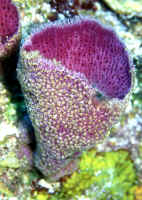 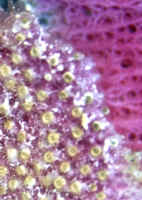
|
| Parazoanthus swiftii, the Golden Zoanthid.
1/4" diameter polyps. Encrust several species of sponges. Here
on a Brown Tube Sponge, Agelas conifera in the Bahamas and
Cozumel. |
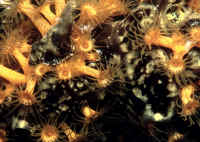 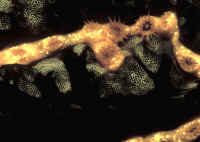
|
| Parazoanthus tunicans, the Hydroid Zoanthid.
1/4 " in size. Tropical West Atlantic. Grow on Feather Tree
Hydroids... not toxic themselves... but don't touch the
hydroid! Cozumel pix by Di. |
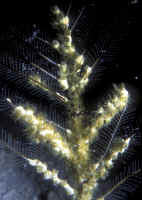 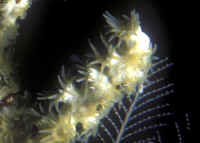
|
| Zoanthus pulchellus, the
Mat Zoanthid. Green, brown flattened discs of up to dime size with
tan tentacles. Also from the Caribbean, the every-now-and-then
offered. Below, in a back reef setting in Tobago and St.
Thomas, U.S.V.I. |
To: Part 1, Part
2, Part 3, Part
4, Part 6, Part
7, Part 8, Part
9, Part 10, Part
11, Part 12, Part
13, Part 14, Part
15,

